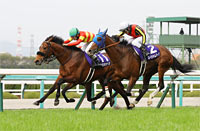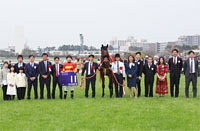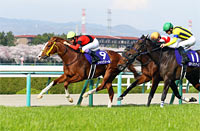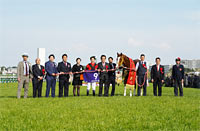Osaka Hai (G1) - Data Analysis
Spring’s middle-distance race for older horses promoted to G1 status
This spring sees a new fixture in the G1 program. Held as a G2 race until last year, the Osaka Hai has been upgraded to become the first middle-distance G1 race for older horses to be held in the spring season. So which name will go down in history as the first winner of this contest in its new guise? Scroll down to see a few points that could be key to success.
Look for runaways but don’t discount stretch runners
To start, let’s look at aggregate performances of runners in 30 graded races (except races limited to 2- and 3-year-olds) held on the 2,000m turf course at Hanshin between 2007 and 2016. In those races, horses rounding the 4th corner in higher positions went on to achieve better success ratios. But runners positioned “10th or lower” at that final turn have also amassed a Top 2 ratio in excess of 10%, not significantly worse than those of the “2nd-5th” and “6th-9th” groups. The conclusion is that front runners are the best bet, but off-pace horses and stretch runners shouldn’t be dismissed too easily either. [Table 1]
[Table 1] Performance by position at the 4th corner (30 graded races held on the 2,000m turf course at Hanshin in 2007-2016, except 2yo and 3yo races)
| Position at 4th corner |
Performance
[1st-2nd-3rd-4th or lower] |
Win ratio |
Top 2 ratio |
Top 3 ratio |
| Leader |
5-6-1-18 |
16.7% |
36.7% |
40.0% |
| 2nd-5th |
13-11-12-111 |
8.8% |
16.3% |
24.5% |
| 6th-9th |
8-7-11-85 |
7.2% |
13.5% |
23.4% |
| 10th or lower |
4-6-6-77 |
4.3% |
10.8% |
17.2% |
Middle horse numbers produce more success
Looking at performances by horse number in those same 30 graded races (except races limited to 2- and 3-year-olds) held on the 2,000m turf course at Hanshin between 2007 and 2016, horses with the middle numbers “6-10” turn out to have the best success ratios. Meanwhile, comparing numbers “1-5” on the inside and “11-16” on the outside, both have produced the same number of Top 2 finishes, even though there have been far more runners in numbers 1-5; in fact, numbers 11-16 have the better success ratios. Despite the apparent disadvantage in terms of race distance, starting in the outer brackets seems to give no grounds for lower expectations. [Table 2]
[Table 2] Performance by horse number (30 graded races held on the 2,000m turf course at Hanshin in 2007-2016, except 2yo and 3yo races)
| Horse number |
Performance
[1st-2nd-3rd-4th or lower] |
Win ratio |
Top 2 ratio |
Top 3 ratio |
| 1-5 |
8-6-13-123 |
5.3% |
9.3% |
18.0% |
| 6-10 |
16-16-13-101 |
11.0% |
21.9% |
30.8% |
| 11-16 |
6-8-4-67 |
7.1% |
16.5% |
21.2% |
Dark horses not uncommon
Viewing performances by favoritism in those 30 graded races (except races limited to 2- and 3-year-olds) held on the 2,000m turf course at Hanshin between 2007 and 2016, horses backed as “1st favorite” have gone on to produce excellent results. But look out for runners billed as “6th-9th favorite” as well – their Win ratio and Top 2 ratio are higher than those of both the “4th favorite” and the “5th favorite,” and are not too far off those of the “3rd favorite.” We should always recognize the potential for less-favored runners to succeed. [Table 3]
[Table 3] Performance by favoritism (30 graded races held on the 2,000m turf course at Hanshin in 2007-2016, except 2yo and 3yo races)
| Favoritism |
Performance
[1st-2nd-3rd-4th or lower] |
Win ratio |
Top 2 ratio |
Top 3 ratio |
| 1st favorite |
11-5-4-10 |
36.7% |
53.3% |
66.7% |
| 2nd favorite |
7-3-4-16 |
23.3% |
33.3% |
46.7% |
| 3rd favorite |
3-2-3-22 |
10.0% |
16.7% |
26.7% |
| 4th favorite |
1-3-5-21 |
3.3% |
13.3% |
30.0% |
| 5th favorite |
0-2-4-24 |
0% |
6.7% |
20.0% |
| 6th-9th favorite |
7-11-5-96 |
5.9% |
15.1% |
19.3% |
| 10th favorite or lower |
1-4-5-102 |
0.9% |
4.5% |
8.9% |
5-year-olds have the better success ratios
Turning next to performances by age in 20 G1 turf races for 4-year-olds and up (except races for fillies and mares only) held between 2007 and 2016, “5-year-olds” have the best success ratios, followed by “4-year-olds” and “6-year-olds.” In G1 turf races for 4-year-olds and up at this time of year, our attention should be on the 5-year-old horses approaching maturity. [Table 4]
[Table 4] Performance by age (20 G1 turf races for 4yo and up in 2007-2016, except females-only races)
| Age |
Performance
[1st-2nd-3rd-4th or lower] |
Win ratio |
Top 2 ratio |
Top 3 ratio |
| 4-year-olds |
5-2-8-64 |
6.3% |
8.9% |
19.0% |
| 5-year-olds |
9-9-4-74 |
9.4% |
18.8% |
22.9% |
| 6-year-olds |
3-7-3-60 |
4.1% |
13.7% |
17.8% |
| 7-year-olds and up |
3-2-5-92 |
2.9% |
4.9% |
9.8% |
Seek out the winner!
Check for a Top 2 finish last time out
All six winners of G1 turf races over distances of 2,000m or more contested by 3- or 4-year-olds and up in 2016 had finished “1st or 2nd” in their previous outing. It will be interesting to see if this trend continues in 2017. [Table 5]
[Table 5] Winners of G1 turf races over 2,000m+ contested by 3- or 4-year-olds and up in 2016, by finish in the previous race
| Race |
Winning horse |
Finish last time |
| Tenno Sho (Spring) |
Kitasan Black |
2nd |
| Takarazuka Kinen |
Marialite |
2nd |
| Tenno Sho (Autumn) |
Maurice |
2nd |
| Queen Elizabeth II Cup |
Queens Ring |
1st |
| Japan Cup |
Kitasan Black |
1st |
| Arima Kinen |
Satono Diamond |
1st |
(Michio Kawano)
|



















